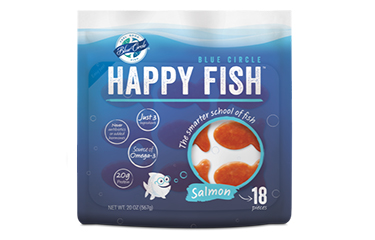Blue Circle expands kid-friendly salmon products distribution

Blue Circle Foods is expanding distribution of its new kid-friendly salmon item in the United States as a group of pediatric doctors is recommending children eat more seafood.
The American Academy of Pediatrics said in a new study that, while most seafood is high in vitamin D, calcium, and long-chain omega-3 fatty acids, most children are not eating enough seafood.
“A growing body of research show that introducing fish early in a child’s diet may even help prevent allergic disease such as asthma and eczema,” AAP said in a press release.
“For families who eat meat, fish should be a welcome part of a child’s diet,” said the report’s lead author Aaron Bernstein, MD, an executive committee member of the AAP Council on Environmental Health. “We’re encouraging pediatricians to ask families about fish and shellfish consumption--since most children don’t eat much beyond the occasional fish sticks--and advise them on the healthiest choices.”
Washington, D.C., U.S.A.-based Blue Circle's new fish-shaped frozen salmon patty, Happy Fish, is sold in about half of Whole Foods Market’s stores across the United States, and will soon be featured in other grocery stores. Happy Fish contains only three ingredients: Atlantic salmon from Nordland, Norway-based Kvarøy, black pepper, and salt.
“We know that the market is ready for a healthier, non-breaded seafood option and Happy Fish fills this void perfectly,” David Pilat, vice president of business development for Blue Circle, told SeafoodSource. The Washington, D.C..-based company supplies fresh and frozen seafood to retailers and foodservice operators in the U.S. and Europe.
Happy Fish was originally rolled out in select Whole Foods Market stores during the 2018 holiday season, and the natural foods chain has been steadily adding the product to additional stores.
Now, Blue Circle is in talks with other U.S. retailers.
“We have had a number of truly excited customers who said it is a terrific product,” Pilat said.
Happy Fish is sold in two sizes: a 7.5-ounce box selling for between USD 4.99 and USD 5.99 (EUR 4.48 and EUR 5.37) each and a 20-ounce bag priced between USD 9.99 and USD 12.99 (EUR 8.96 and EUR 11.65) each.
This fall, the supplier plans to add cod to the Happy Fish line because “some retailers prefer having two SKUs,” Pilat said. Similar to the salmon product, the cod Happy Fish will contain only three ingredients: cod, pepper, and salt.
Happy Fish can be sautéed from frozen in a pan for just two minutes on each side. It can also be baked, grilled and boiled.
“You can boil pasta and then add it to the boiling water - it will hold its shape,” Pilat said.
While the initial rollout is in the U.S., Blue Circle will eventually expand the line to Europe, according to Pilat.
Last year, the supplier focused on European expansion, hiring Peter Luxhoi, based in Aalborg, Denmark, as its new director of European operations. In the European Union market, Blue Circle will first go after the retail market and then move into foodservice with fresh, frozen, and value-added offerings, according to Pilat.
“Similar to the U.S., we know that demand for sustainable seafood in Europe is on the rise,” Pilat said at the time. “The European market is wide open right now. They understand sustainable seafood and innovation, and we are hoping to grow exponentially.”
Meanwhile, AAP researchers said that seafood consumption by U.S. children has declined every year since 2007, primarily because of parents’ concerns about methylmercury pollution.
However, the AAP says exposure to mercury in fish can be minimized or avoided based on U.S. Food and Drug Administration and Environmental Protection Agency guidance. The agencies recommend children and women who are pregnant or breastfeeding eat one to two weekly servings of a variety of fish among the “best choice and "good choice" categories identified by the two groups.
The AAP also recommends that the sustainability of different types of fish and shellfish be factored into seafood choices.
“Some of the world’s fishing grounds are being over-harvested. In certain regions, especially for shrimp farming, child labor and environmentally damaging practices are used. In general, the best choices for sustainably caught or raised fish and shellfish most often come from U.S. fisheries,” AAP said.






Share